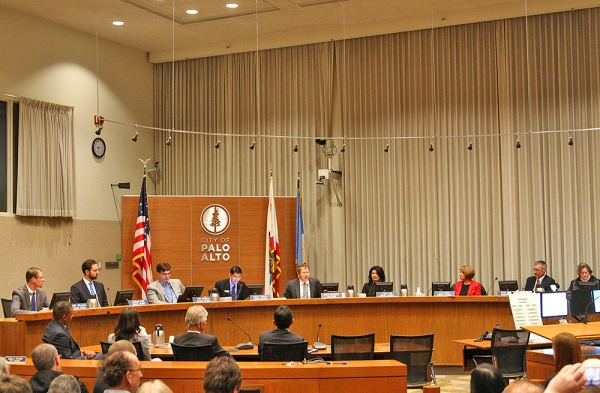• Weekly journalists discuss this issue with Palo Alto Vice Mayor Eric Filseth on an episode of "Behind the Headlines." Watch the webcast here.
An effort by four Palo Alto council members to make murky labor negotiations more transparent gained momentum this week, when the entire City Council endorsed the proposed reforms.
Now, it will be up to the council's Finance Committee to refine the proposal, which would then be brought to the labor groups for meet-and-confer discussions.
A central component of the proposal from Vice Mayor Eric Filseth and council members Tom DuBois, Greg Scharff and Greg Tanaka is publicizing every formal written proposal made or received by the city during the course of labor negotiations within two days of transmittal. Each offer would be accompanied by a fiscal analysis outlining its pension and health care terms and their effects on the city's liabilities.
The proposal also calls for staff to prepare fiscal summaries of costs and liabilities associated with each bargaining unit. These summaries will be posted on the city's website along with the agenda listing the closed session negotiations.
If the two sides fail to reach an agreement, city staff will post each side's last, best and final offer, as well as the fiscal analyses of the two offers.
Filseth, the lead author of the colleagues memo that outlined the proposal, noted Monday that the city's existing process affords little opportunity for the public to weigh in. All negotiations take place behind closed doors and residents usually don't learn about the results until an agreement is reached and a memorandum of understanding is released for council approval.
"By that time, it's essentially too late for public review and comments to have any bearing on the outcome of the process," Filseth said.
The council vote on the colleagues memo came at the end of a long meeting that began with a closed session on labor negotiations. The city is preparing to kick off discussions of new contracts with all of its major labor unions, including its largest union, the Service Employees International Union, Local 521; the non-unionized group of about 200 managers and professionals; its police and firefighter unions; and Utilities Management and Professional Association of Palo Alto, which represents utility workers.
The proposal also comes at a time when the council is making a concerted effort to better measure and manage its pension backlog, which is estimated at more than $300 million but which some believe may approach $1 billion (the variation is based on different assumptions about rates of return at CalPERS, the giant pension fund that administers Palo Alto's plans). In early February, the council adopted "finance" as one of its top priorities for the year, with a special emphasis on infrastructure funding and pensions.
Filseth noted Monday that the pension discussion involves "hundreds of millions in public debt." The memo also underscores that the outcomes of labor negotiations -- particularly as they pertain to unfunded liabilities -- "are public concerns which will be borne by the community for decades, and merit meaningful public review."
"The city is a public agency," Filseth said. "This is a major public concern, and it merits public review and input and transparency."
DuBois called the proposal "carefully considered" and predicted that it will help the public, the city and employees. The recommendations in the memo, he said, are modeled after existing provisions in other cities. San Jose, for example, has a policy of posting every formal proposal within two days of transmittal. Fullerton also publicizes each offer, accompanied by a fiscal analysis.
"I think having transparency in this process will help bring the public along so they can understand why our labor agreements are the way they area," DuBois said.
Other council members agreed, with Mayor Liz Kniss calling the memo's recommendations a "creative proposal" and Councilwoman Karen Holman saying she hopes the increased sunshine will foster a more collaborative environment in the labor talks.
Scharff said adding transparency will also force people to "start in more reasonable positions," knowing that their offers will be publicly scrutinized.
"You'll see people make more thoughtful offers that they can put in the public eye," Scharff said.



Comments
Palo Alto Hills
on Feb 28, 2018 at 7:30 pm
on Feb 28, 2018 at 7:30 pm
Great news! The citizens need to see what “is on the table”, so they can have input before labor agreements are voted on.
Menlo Park
on Feb 28, 2018 at 9:38 pm
on Feb 28, 2018 at 9:38 pm
Zero raises and zero total compensation increases until the pension is fully funded. Pass CALPERS increases on to employees and maintain constant total compensation. The problem will correct itself in short order. I recently calculated the retirement benefits of a local school district employees at 16X what those of us in the private sector receive (which, for the private sector, is on average a 2.7% 401k match and nothing further upon retirement). It is likely similar for city employees. They could tolerate a hair cut to bring their retirement benefits within an order of magnitude of the rest of us.
Adobe-Meadow
on Mar 1, 2018 at 9:46 am
on Mar 1, 2018 at 9:46 am
Grateful to Eric and Tom and the two Gregs for coming together on this important issue. Eric Filseth showed real leadership in making this happen.